|
Old Photography Gear From 2004
|
|
Page 1 of 2 Page 2
Return to my Current Gear page
The following gear makes up the bulk of my current photographic toolkit. There are other tools that
aren't listed here, such as Compact Flash cards, Ni-MH rechargeable batteries, specific filters, and flash accesories, but
the bulk of what I use regularly is listed below. There are many images in my gallery that were shot on a Canon EOS D60, and even a handful
that were shot on a Minolta Maxxum 9 with Fujichrome Velvia ISO 50 film, but the vast majority were shot with my Canon EOS 1Ds and EOS 10D.
I also make regular use of Adobe Photoshop 7.0 and CS (8.0).
Last Updated: 04/07/2004
|
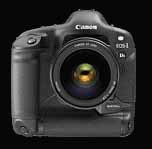 |
Canon EOS 1Ds Digital SLR Body - This is the latest addition to my toolkit. This camera has a fullframe, 11.1-megapixel CMOS sensor, which means that there is no focal length conversion to deal with and the resolution is superb. Unfortunately, the Ni-MH batteries for the 1Ds are not the same as those required for the 10D, which means that I now have to purchase a whole new set of batteries, and they are not cheap.
|
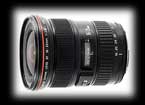 |
Canon 16-35mm USM Wide-Angle Zoom Lens -
This lens has replaced my Sigma 17-35mm f/2.8-f/4 lens. I decided to replace the Sigma lens for two reasons: the autofocus stopped working and the Canon lens is faster and of higher quality. This is now my primary lens for shooting wide-angle landscape shots. I can also use this lens with my Canon Teleconverters. With the 1.4x Teleconverter I get a 22-50mm range with an f/4 aperture.
|
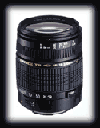 |
Tamron 28-300mm f/3.5-f/6.3 Zoom Lens - This is the most flexible, all-purpose lens that I own.
There is some quality loss in exchange for the flexibility and focal length range, but to me this is completely
acceptable when travel situations dictate the use of small lens. If I'm able to have all of my gear with me when traveling, this lens no longer gets much use now that I have the Canon 70-200mm f/2.8 IS lens.
|
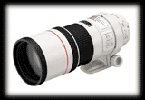 |
Canon 300mm f/4 Image Stabilizer Telephoto Lens -
I love this lens. I'd give anything to have a 300mm f/2.8 lens that was this size and weight,
but since this is not an option given the current state of technology and optics, this is next best thing.
I almost always use this this lens with my Canon 1.4x teleconverter. With the 10D sensor conversion factor and
the 1.4x teleconverter, I have
an effective f/5.6 670mm Image Stablizer lens. It's relatively small, light, sturdy, and it's easy to whip out of my bag when a wildlife photo opportunity
presents itself.
|
 |
Canon 400mm f/2.8 Image Stabilizer Telephoto Lens -
With its long focal length, its huge aperture, and the IS system, this lens is the bomb! But at 13.7" and 11.8 lbs, it's certainly not the most practical lens in the world. I need a huge photo backpack to carry this lens around in, and I also need a large, heavy tripod with a gimble head to support it when shooting. I did use this lens while visiting the Ding Darling Wildlife Refuge on Sanibel Island, Florida, because I was able to drive around the park loop, and easily set up the tripod and lens on the roadside. Other than that, the lens just isn't very useful to me...especially when it cost me $6,800!!!! :O
|
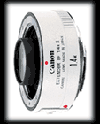 |
Canon 1.4x Teleconverter - I primarly use this teleconverter with my Canon f/4 300mm telephoto IS lens. I occasionally use it with my 400mm f/2.8 IS lens, but it
remains connected to my 300mm lens in my photo bag 90% of the time. It makes my 300 f/4 lens a f/5.6 lens, but it increases the focal length
and the Image Stablizer technology reduces the impact of the loss of light that the teleconverter causes.
|
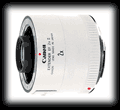 |
Canon 2x Teleconverter - This teleconverter is only used with my Canon 400mm f/2.8 lens in all but the rarest of occasions.
I've used it with my 300mm f/4 lens in the past, but it only provides me with an f/8 aperture, which is not very practical unless there
is plenty of light and the background is far enough away where the increase in depth of field does not produce an image with a distracting background.
When combined with my 400mm f/2.8 lens, I get an effective focal length of 1280mm (400 x 2x teleconverter x 1.6 sensor conversion) with a f/5.6 aperture.
|
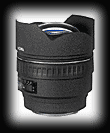 |
Sigma 14mm Fisheye Lens - This lens is great for capturing exteme wide-angle shots, but I rarely use it. I'm not a big fan of heavily distorted wide-angle shots, so I just don't find myself using this lens that often. I like wide-angle lenses for landscape shots with foreground interest, but I prefer the flexibility of the Canon 16-35mm lens over the Sigma 14mm lens.
|
 |
Canon 180mm Macro f/3.5 USM Lens - This is an excellent macro lens. Although I enjoy still life macro photography,
I get the most pleasure from photographing small insects in their natural habitat. I used to use a 100mm Canon macro lens, which was
also a great lens, but the extra 80mm helps when approaching a small, wary insect that is likely to flee the scene when a big lens gets within inches of them.
I sometimes use the Canon Twin Macro-Lite Flash with this lens when the natural lighting conditions aren't right.
|
|
Page 1 of 2 Page 2
|
|
 |


![]()


![]()